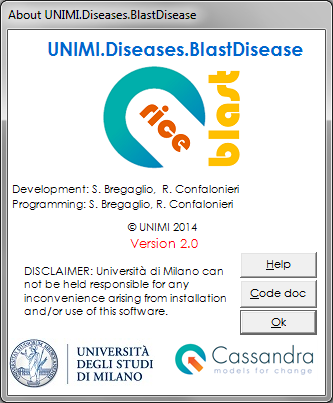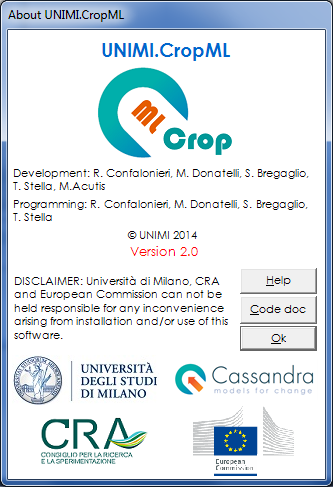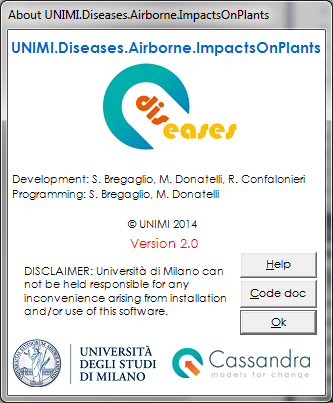Predicting rice blast disease: machine learning versus process-based models
 |
2019 - BMC Bioinformatics, 20, 514 |
 |
Nettleton, D.F., Katsantonis, D., Kalaitzidis, A., Sarafijanovic-Djukic, N., Puigdollers, P., Confalonieri, R. |
Abstract:
Background: In this study, we compared four models for predicting rice blast disease, two operational process-based models (Yoshino and Water Accounting Rice Model (WARM)) and two approaches based on machine learning algorithms (M5Rules and Recurrent Neural Networks (RNN)), the former inducing a rule-based model and the latter building a neural network. In situ telemetry is important to obtain quality in-field data for predictive models and this was a key aspect of the RICE-GUARD project on which this study is based. According to the authors, this is the first
time process-based and machine learning modelling approaches for supporting plant disease management are compared.
Results: Results clearly showed that the models succeeded in providing a warning of rice blast onset and presence, thus representing suitable solutions for preventive remedial actions targeting the mitigation of yield losses and the reduction of fungicide use. All methods gave significant “signals” during the “early warning” period, with a similar level of performance. M5Rules and WARM gave the maximum average normalized scores of 0.80 and 0.77, respectively, whereas Yoshino gave the best score for one site (Kalochori 2015). The best average values of r and r2 and %MAE (Mean Absolute Error) for the machine learning models were 0.70, 0.50 and 0.75, respectively and for the process-based models the corresponding values were 0.59, 0.40 and 0.82. Thus it has been found that the ML models are competitive with the process-based models. This result has relevant implications for the operational use of the models, since most of the available studies are limited to the analysis of the relationship between the model outputs and the incidence of rice blast. Results also showed that machine learning methods approximated the performances of two process-based models used for years in operational contexts.
Conclusions: Process-based and data-driven models can be used to provide early warnings to anticipate rice blast and detect its presence, thus supporting fungicide applications. Data-driven models derived from machine learning methods are a viable alternative to process-based approaches and – in cases when training datasets are available – offer a potentially greater adaptability to new contexts.
time process-based and machine learning modelling approaches for supporting plant disease management are compared.
Results: Results clearly showed that the models succeeded in providing a warning of rice blast onset and presence, thus representing suitable solutions for preventive remedial actions targeting the mitigation of yield losses and the reduction of fungicide use. All methods gave significant “signals” during the “early warning” period, with a similar level of performance. M5Rules and WARM gave the maximum average normalized scores of 0.80 and 0.77, respectively, whereas Yoshino gave the best score for one site (Kalochori 2015). The best average values of r and r2 and %MAE (Mean Absolute Error) for the machine learning models were 0.70, 0.50 and 0.75, respectively and for the process-based models the corresponding values were 0.59, 0.40 and 0.82. Thus it has been found that the ML models are competitive with the process-based models. This result has relevant implications for the operational use of the models, since most of the available studies are limited to the analysis of the relationship between the model outputs and the incidence of rice blast. Results also showed that machine learning methods approximated the performances of two process-based models used for years in operational contexts.
Conclusions: Process-based and data-driven models can be used to provide early warnings to anticipate rice blast and detect its presence, thus supporting fungicide applications. Data-driven models derived from machine learning methods are a viable alternative to process-based approaches and – in cases when training datasets are available – offer a potentially greater adaptability to new contexts.
 |
Keywords: Rice blast, forecasting, machine learning, predictive models, rule induction, neural networks |
 |
DOI: 10.1186/s12859-019-3065-1 |
- Comparison of three calibration methods for modeling rice phenology
- A simple pipeline for the assessment of legacy soil datasets: An example and test with soil organic carbon from a highly variable area.
- A high-resolution, integrated system for rice yield forecasting at district level.
- Downscaling rice yield simulation at sub-field scale using remotely sensed LAI data.
- Analysis and modelling of processes involved with salt tolerance and rice.
- Estimating crop nutritional status using smart apps to support nitrogen fertilization. A case study on paddy rice.
- Development of generic crop models for simulation of multi-species plant communities in mown grasslands.
- Quantifying uncertainty due to stochastic weather generators in climate change impact studies
- Predicting rice blast disease: machine learning versus process-based models
- Boundaries and perspectives from a multi-model study on rice grain quality in Northern Italy.







